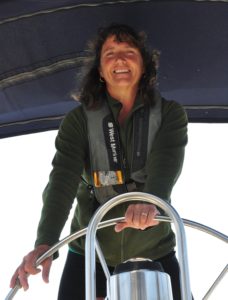By Beth Palma
Beth is a charter sailboat captain sailing out of Bayfield, Wisconsin on Lake Superior. Beth, an American Red Cross volunteer, is passionate about water safety and sharing skills.

The glorious days of summer are nearly here. Before long, the sun and the sweetness of the breeze will warm us. Our lakes and rivers will come alive with the abundance of water activities.
I grew up on a small lake in Wisconsin taking American Red Cross swimming lessons, waterskiing and canoeing. As an adult, I romanticized about the sailboats on Lake Superior, and I finally found my opportunity for sailing at the age of 41.
My husband, Pat, and I moved our young family to Washburn, WI on the shore of Lake Superior. I signed my three children up for a community sailing program and offered to help. In the span of 10 years, I went from “mom helper” all the way to spending seven years as the program director.
I kept sailing and found opportunities to race on the “big” boats and find crew spots in the area. In 2014, I received my U.S. Coast Guard Merchant Mariner credential, and I’ve been a charter boat captain ever since. My love for boating and being on and in the water is why I know how important it is to practice water safety.

Whether swimming, boating, or hanging out on the shore, we all need to be aware of the dangers and educate our youth, and ourselves, on safe practices.
Drowning is the second-leading cause of unintentional death in children ages 1-14. Statistically, if a parent or guardian does not swim, their child most likely does not know how to swim either. Only 54% of the United States population can swim, according to the U.S. Government Center for Disease Control and Prevention.
Here are a few safety tips for swimmers and boaters:
Learn to swim & learn CPR. Formal swimming lessons can protect kids and adults from drowning. Enroll in your community’s swim program, such as Red Cross Learn-to- Swim lessons. The Red Cross has been the leader in teaching water safety since 1914, reaching millions of Americans through its innovative water safety resources. Learning CPR can also save a life. In the time it might take for help to arrive, your CPR skills could make a difference.
Watch children in or near the water. Even when children have had formal swimming lessons, constant supervision is necessary. Don’t be distracted, (such as reading, or on the phone) while watching children.
Use the buddy system & know the terrain. Regardless of your age, always swim with a buddy. Try to select swimming sites that have lifeguards, whenever possible. Be aware of and avoid drop-offs and hidden obstacles in the water. Always enter water feet first. Never dive in where you do not know what is below the surface.
Use U.S. Coast Guard (USCG) approved life jackets, when boating, regardless of distance, size of boat, or swimming ability of boaters. Also use life jackets while swimming if unsure of the swimmers ability. Federal law requires children under the age of 13 to wear a USCG-approved life jacket while underway in a boat. Do not use air-filled or foam toys, such as “water wings”, “noodles”, or inner tubes, in place of life jackets. These toys are not designed to keep swimmers safe.
Take a boaters safety course. There are many providers that are approved by the United States Coast Guard including U.S. Coast Guard Auxiliary, Boat U.S., and US Sailing. State Departments of Natural Resources recommend all boat operators complete a safety course.
Check local forecasts before swimming or boating outdoors. Strong winds and thunderstorms with lightning strikes are dangerous. Be prepared for cold water, and know the signs of hypothermia.
I hope you get out and enjoy our lakes and rivers, but don’t forget to respect the water. We in the Midwest have a tremendous appreciation of the Great Lakes because they are the deadliest bodies of lake water in the world. But, with awareness, water safety training with the Red Cross and boater safety courses, we can all take part in reducing the potential for water-related loss of lives and drowning incidents.
